Managing crisis communication with audience intelligence & sentiment
Scandals, health concerns, environmental stances, social leanings, executives, influencers, and political views can make or break a brand. It goes without saying that brands who ‘take a stand’ on any issue exhibit a transparency-forward message and put themselves at risk with customers who may not share their views, or may not believe their mission is sincere. This is the crux of PR crisis communications.
We see this unfolding in the news as we speak given this month marked International Women’s Day where Hershey’s, the longstanding chocolate company, included a transgender woman (Fae Johnstone) in a campaign to “celebrate women changing the future.”
“Johnstone, an activist, and consultant based in Ontario was one of five people featured in a Canadian PR campaign for Women’s History Month and International Women’s Day on March 8. Johnstone, who uses she/they pronouns, tweeted a 15-second ad for the “#HERforSHE” campaign Wednesday, saying: “The chocolate's out of the wrapper! Honoured to be featured in this campaign by @Hersheys Canada for #InternationalWomensDay alongside 4 brilliant sisters and change-makers,” reports David Gilbert of Vice News.
Hershey’s Canada has since responded to the backlash, saying the company “value[s] togetherness and recognize[s] the strength created by diversity.”
The company also wrote in a message shared via Instagram:
"Over the past three years, our Women’s History Month programming has been an inclusive celebration of women and their impact. We appreciate the countless people and meaningful partnerships behind these efforts," it explained.
Crisis communication management is no easy feat. But devil be damned, Hershey’s chose to double down on its views and ignore the abuse. And this isn’t the first time we’ve seen big-name brands do this.
Another example was Nike with its BLM-focused campaign back in 2016. It featured the former NFL quarterback, Colin Kaepernick, and the slogan: “Believe in something. Even if it means sacrificing everything. Just do it.” In 2016, Kaepernick started to kneel for the pre-game national anthem in protest of racial injustice in the United States and Nike stood by him in solidarity.
Other brands have not been so fortunate. The recent scandal around the menstrual-underwear company, Thinx, comes to mind. The brand claimed to be a safe and environmentally positive alternative to tampons and pads. Still, a customer decided to third-party test the briefs and discovered they contained high amounts of toxic chemicals. This discovery led to a class action lawsuit, which Thinx ultimately lost, leaving the brand with an uncertain future among its core customers.
Throughout this post, we will use Affinio with the help of Talkwalker to unravel sentiment around a PR crisis— namely the #BoycottHersheys hashtag. Powering your PR communications with audience intelligence and audience sentiment is a powerful way to understand if a crisis is real or merely fake news.
Sentiment + Intelligence: Unraveling The Audience Around the #BoycottHersheys PR Crisis
To begin our analysis, we ran a simple topic query in Talkwalker on those discussing either #boycotthershey or #boycotthersheys in the last 30 days. From here, we filtered the social author results by topic sentiment and uploaded a separate list into Affinio for each of positive and negative.
For this blog, we are focusing the analysis on the “negative sentiment” audience lens so a PR team can understand the very passionate stakeholder groups engaged in the conversation to know if/how to handle them (whether this negativity stems from being anti-Hershey’s or anti-boycott).
The audience is segmented into like-minded groups by their common interests. We assessed the audience breakout based on cluster size, impact, and voice and will offer a quick summary of each segment with example tweets that illustrate the tone and sentiment.
-1.png?width=608&height=567&name=image2%20(2)-1.png)
Activists & Chocolate Snobs: (36%)
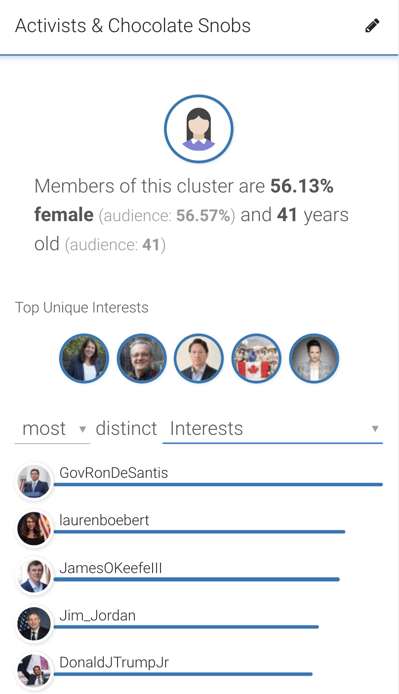
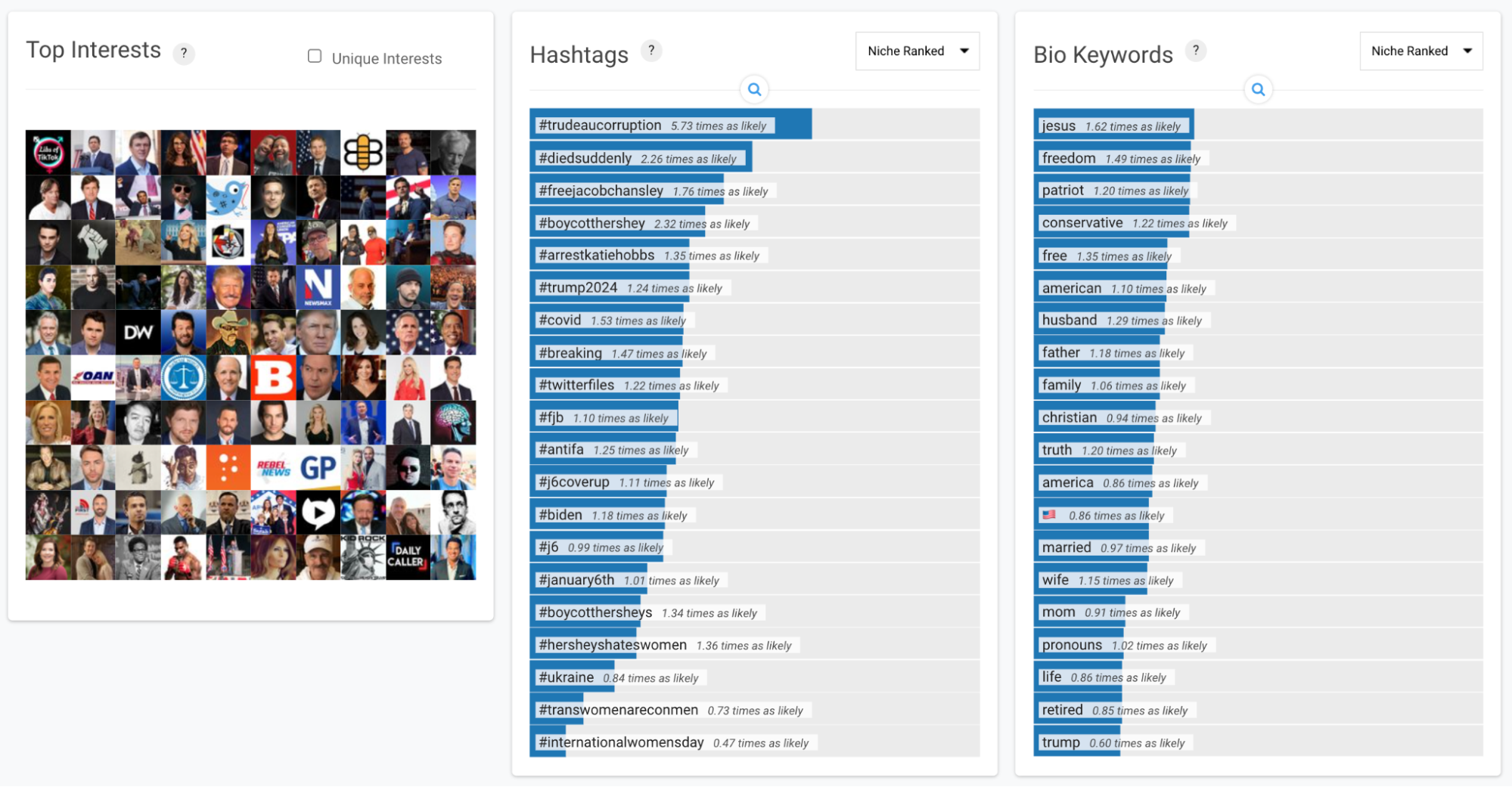
This largest cluster represented just over one-third of the audience size and included a mix of people who protest and boycott just about everything, and more distinctly, these same people aren’t fans of Hershey's chocolate quality either. Skewing older Millennials and younger Gen X in age, the cluster is also 56% female.
Beyond being chocolate connoisseurs — this cluster is focused on right-leaning politics, and they have various political agendas including a mission to both “free” some social or political figures, and “arrest” others.
Here are some tweets from the audience to illustrate their sentiment:
#boycottHershey Their chocolate is 💩 anyway
— Sassy Patriot (@Sassypatriot133) March 4, 2023
Best response I've seen regarding this whole fiasco. #BoycottHersheys #boycottHershey #HersheysHatesWomen https://t.co/a1C1hPSEF6
— Shutterly Perfect Photography/Christena (@Christena7272) March 3, 2023
Conservatives: (36%)
Brands that prioritize transgender awareness and inclusivity may face challenges in keeping customers who hold discriminatory views or who may be uncomfortable with the brand's stance on these issues.
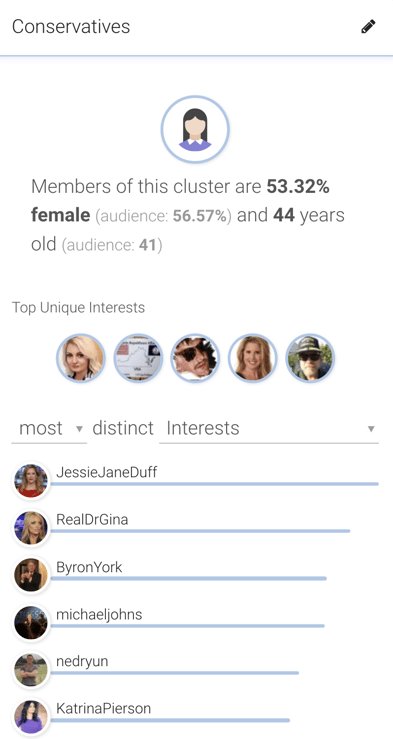
.png?width=1999&height=1044&name=image16%20(1).png)
One challenge that such brands may face is backlash from customers who typically hold anti-transgender beliefs, such as Conservatives. Some customers may boycott the brand or publicly criticize it on social media or other platforms. This can lead to negative publicity which can impact the brand's reputation and sales.
#BoycottHersheys Apparently, they couldn't find enough real women to use in a campaign for Women's Day, so they picked a guy in a dress. #WomanFace
— Tishia (@TishiaIsMe) March 2, 2023
Here are their products. Easter is coming. Skip the @Hersheys pic.twitter.com/uobZrc8c7s
So @Hersheys is featuring a male in costume as a woman for its international women's day ad campaign. https://t.co/PbxV8ZJD1Q
— Mollie (@MZHemingway) March 2, 2023
NOT / BUYING #BoycottHersheys
— Laura Marklin (@LauraMarklin) March 6, 2023
This cluster is characterized by those not allying with trans culture. They show up in both the Negative and Positive sentiment audiences since their strong views position them as Hershey's detractors yet their gloating over the boycott movement shows them as promoters of the topic.
Also, this group had a tendency to tweet about all Hershey's products beyond the chocolate bars to bring awareness to their broader portfolio for boycotting. Given the proportional cluster size (29%), this could be very damaging to the brand.
Anti-haters (12%):
The Anti-Haters cluster comes in at 12% of the audience size and skews 61% females aged over 40. This largely liberal group is negative in sentiment about the boycott movement and supports the brand’s inclusivity efforts.

.png?width=1999&height=1039&name=image4%20(1).png)
The Anti-Haters group had the second strongest affinity towards the Hershey’s brand after the Hashtag Satire group.
.png?width=612&height=721&name=image22%20(1).png)
Some in this cluster also point out the hypocrisy of the #boycotthersheys topic getting so much more attention than other reports of child labor happening in the chocolate-making industry, suggesting they won’t support the boycott for that reason alone.
However, this group does support another boycott — i.e. the #boycottwalgreens movement around that chain’s alleged refusal to sell abortion pills in some states (yet a different PR crisis).
Screw you!!! I will not #BoycottHersheys
— RickGamesNow on YouTube (@rickgamesnow) March 2, 2023
Stop being a bunch of bitchy ass crybabies.
I think I'll buy a Hershey's bar today, so I will not #BoycottHersheys. Haters just take the fun out of everything.
— Chris Bitados (@CBitados) March 2, 2023
Many brands and companies have recently taken steps to show support for the transgender community and promote transgender awareness and inclusivity, so despite this being a smaller cluster, Hersey’s is following suit with other highly regarded brands moving in the same direction. Here are a few examples:
Ben & Jerry's: The ice cream company has been vocal about its support for transgender rights, including publishing a statement on its website calling for an end to discrimination against transgender people.
Nike: Nike has released a line of gender-neutral athletic wear, and the company's "Be True" campaign has featured transgender models.
Google: Google has added a "gender transition" option to its list of employee benefits, and the company has taken steps to make its products and services more inclusive of transgender people.
Airbnb: Airbnb has updated its non-discrimination policy to specifically include gender identity as a protected category.
H&M: H&M has released a gender-neutral clothing line, and the company has featured transgender models in its advertising campaigns.
Overall, many brands and companies recognize the importance of supporting transgender rights and promoting inclusivity. By taking a clear and consistent stance on these issues, these brands can differentiate themselves from competitors and build a strong reputation as socially responsible and inclusive companies.
Hashtag Satire (12%):
This youngest cluster is making a meme out of the whole discussion. Many of those in the audience have gamer inclinations and specifically are fans of Sonic the Hedgehog and Undertale video games.
.png?width=553&height=441&name=image15%20(1).png)
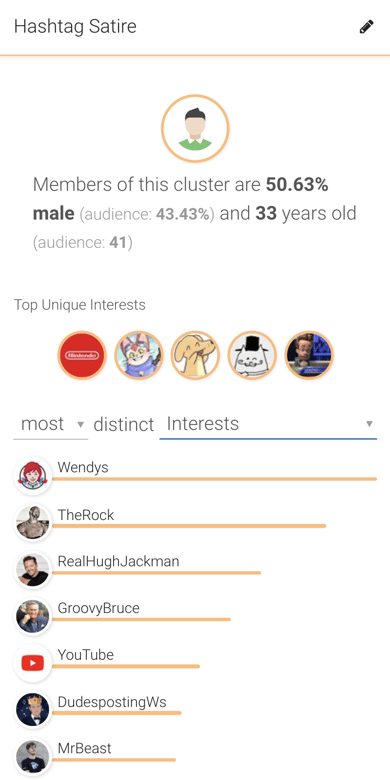
-1.png?width=1999&height=1039&name=image4%20(1)-1.png)
As shown earlier, this group also had the highest affinity towards Hershey's, since they are truer candy fans and not as invested in political stances.
Despite representing a smaller share of voice, this group is still adding to the conversation by putting a light spin on the topic with the use of satire-driven memes.
#BoycottHersheys because you call that chocolate?
— Hol's Kitchen (@HolsKitchenPOD) March 2, 2023
This is unacceptable 😡 #BoycottHersheys pic.twitter.com/Nx7hGFleCN
— 🩶🤍❤️gabbu❤️🤍🩶 (@gabbuquail) March 2, 2023
Feminists for #sexnotgender (10%):
Often coined radical feminists, this group supports traditional female definitions, especially as it relates to subjects like fair play for girls. This cluster was most inclined to use the hashtag #HersheysHatesWomen and some even self-described in bios with terms like #IstandwithJKRowling.
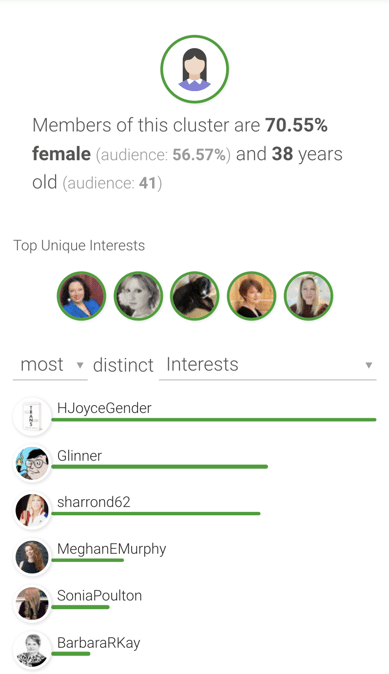
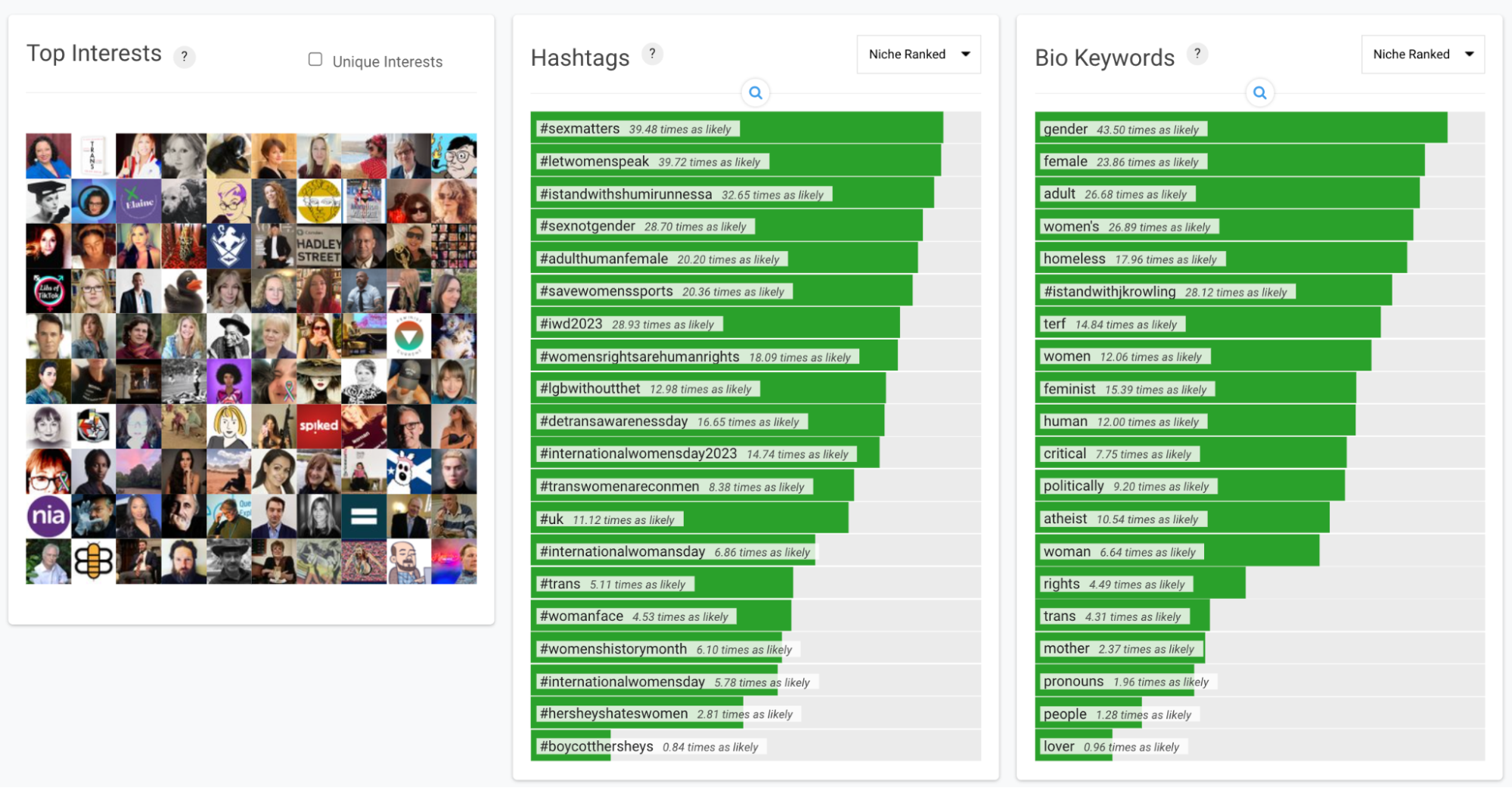
When radical feminists or any other group do not support a brand's decisions for inclusivity, it can create a difficult situation for the brand. On the one hand, the brand may want to promote diversity and inclusivity and take a clear stance on social justice issues—as Hershey’s did. On the other hand, it may face backlash or criticism from customers or other stakeholders who do not agree with its position—the focus of this post.
Conclusion
Interestingly, across all clusters except one, Hershey's still ranked as a stronger chocolate brand interest than the competitive brands: M&M, Nestle, and Cadbury.
In some cases, brands like Hershey’s may choose to ignore the criticism and take a firm stance in support of their initiatives. This could be risky, as it may lead to further controversy and negative publicity. In other cases, brands may try to find a middle ground by addressing the concerns of critics while still promoting their intentions.
Overall, brands must carefully consider the feedback they receive and weigh it against their values and goals, and they may want to evaluate the size and extent to which the dissenting segments actually align with their ICPs.






